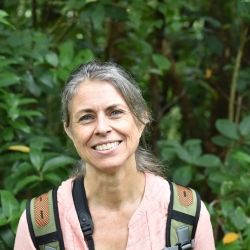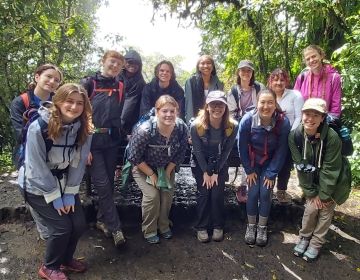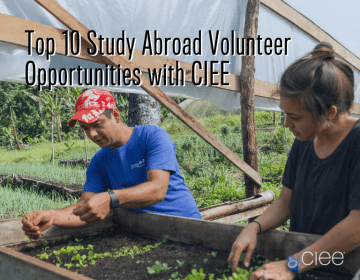On the Road
by Mabel Baez, awesome intern teaching assistant. Sunday, September 13, 2015
Today we started our epic journey around the Pacific slope of Costa Rica investigating renewable energies and water resources. We boarded our magic school bus, accompanied by one of our favorite drivers, Grevin (a.k.a., Gravy). Once in the Gravy Train, we bumped the entire way over the mountainous, winding path, until we stopped amidst numerous wind farms. We looked at real life examples of different wind turbine models, learned the mechanisms behind wind power, and talked about environmental and social impacts.
Isabel, lost in deep thoughts about the neodymium-iron-boron gearbox.The wild winds then blew us right to the shores of Lake Arenal, a man-made reservoir, which is one of the biggest sources of electricity in Costa Rica. Overall hydropower provides approximately 80% of Costa Rica’s energy, with the Arenal system contributing about 30% of it. Lake Arenal doesn’t just provide electricity- it is also utilized for recreational and economic activities. One of these is Tilapia aquaculture. Though tilapia is an aggressive invasive, it is also coveted by many. We were lucky enough to have Ismael educate us on farming tilapia, and then boated out into the free-floating cages to catch some ourselves! (We successfully did our part to remove exotic species from the habitat.)
Rachel expresses her love for everything tilapia. How to make friends and influence people, with tilapia.Monday, September 14, 2015
We washed our fishy hands and began Day Two with visits to the power plants that make up the Arenal hydropower complex. Interestingly, the system is made up of three different power plants- The Arenal power house, the Corobici power house and finally the Sandillal power house. This system takes maximum advantage of the mechanical energy of the water to maximize electricity production before irrigating the Pacific side of the country through a series of canals. Today we learned the mechanics of hydropower, as well as the social, economic and ecological impact of such large-scale project.
Off we were to Guayabo, a small town at the foot of the Miravalles Volcano. Here we joined the locals in celebrating the eve of Independence Day! On this night, a torch, which is brought over from Nicaragua, makes a turn around all the towns in the country. People create their own faroles, or lanterns, and parade around town singing the national anthem and other traditional songs. Tonight, after assembling our very own very own faroles, we joined the locals to celebrate Independence Day Eve, like Ticos! (We blended in very well.)
Local school children prepare for the festivities. (Er, where is the chaperone?) When CIEE came to town.Tuesday, September 15, 2015: Día de la Independencia
To celebrate Costa Rica's Independence Day we put on our boots and hiked around Rincón De La Vieja National Park, which encompasses the majestic Rincón de la Vieja Volcano. Here, under the shade of the tropical forest we saw mud pots, coral snake mimics, agoutis, king vultures, and iguanas! Just as we thought we were about to melt from the afternoon heat, we ended up at a spectacular waterfall where we cooled off before hiking back to the Gravy Train. (Alas, Gravy had some pressing business with iguanas, which involved chasing them up trees.)
Shawn and Maya, feeling pretty good about conquering the strangler. Gravy, feeling pretty good about life and lizards. Catarata la Cangreja, Parque Nacional Rincón de la ViejaWednesday, September 16, 2015
After a soak in the hotel’s thermal pools and a good night’s rest, we hopped on the Gravy Train to investigate the ways in which the very same geothermal activity we witnessed the day before is harnessed to produce electricity!
We were also lucky enough to tour the adjacent solar power plant- the first of its kind in the country and in Central America.
After our last tour of the facilities we are experts on four kinds of renewable energy - wind, solar, hydropower, and geothermal!
Rachel is okay with solar, but can't stop daydreaming about tilapia. CIEE graduates: Future power brokers.
Related Posts
Costa Rica vs. Argentina: Which is Better for Study Abroad?
Imagine yourself sipping mate in a bustling Buenos Aires café or lounging peacefully in a hammock overlooking Costa Rica's lush rainforests. These contrasting scenes represent just a glimpse of the... keep reading
Happy Earth Day: Today and Every Day
Happy Earth Day! Every April 22, this global event comes around to remind us how precious our planet is, what sustainable efforts we can make to protect Earth, and that... keep reading
Top 10 Study Abroad Volunteer Opportunities with CIEE
Have you ever wondered if you could volunteer abroad? Perhaps you're looking into study abroad programs that provide international volunteer opportunities. If you’re itching to study abroad and truly make... keep reading



